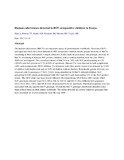| dc.contributor.author | Mans, J | |
| dc.contributor.author | Murray, TY | |
| dc.contributor.author | Kiulia, NM | |
| dc.contributor.author | Mwenda, JM | |
| dc.contributor.author | Musoke, RN | |
| dc.date.accessioned | 2013-10-23T06:42:53Z | |
| dc.date.available | 2013-10-23T06:42:53Z | |
| dc.date.issued | 2013-10-12 | |
| dc.identifier.citation | J Med Virol. 2013 Oct 12. doi: 10.1002/jmv.23784 | en |
| dc.identifier.uri | http://www.ncbi.nlm.nih.gov/pubmed/24123054 | |
| dc.identifier.uri | http://onlinelibrary.wiley.com/doi/10.1002/jmv.23784/full | |
| dc.identifier.uri | http://erepository.uonbi.ac.ke:8080/xmlui/handle/123456789/57837 | |
| dc.description.abstract | The human caliciviruses (HuCVs) are important causes of gastroenteritis worldwide. Norovirus (NoV) and sapovirus (SaV) have been detected in HIV-seropositive children but the genetic diversity of HuCVs circulating in these individuals is largely unknown. In this study the prevalence and genotype diversity of HuCVs circulating in Kenyan HIV-positive children, with or without diarrhea, from the year 1999 to 2000 was investigated. The overall prevalence of HuCVs was 19% with NoV predominating at 17% (18/105) and SaV present in 5.7% (6/105) of specimens. Human CVs were detected in both symptomatic (24%) and asymptomatic (16%) children. Co-infections with other enteric viruses were detected in 21.6% of children with diarrhea but only in 4.4% of children without diarrhea. Remarkable genetic diversity was observed with 12 genotypes (7 NoV, 5 SaV) being identified in 20 HuCV-infected children. NoV genogroup II (GII) strains predominated with GII.2 and GII.4 each representing 27% of the NoV-positive strains. The GII.4 strain was most closely related to the nonepidemic GII.4 Kaiso 2003 variant. Other NoV genotypes detected were GI.3, GII.6, GII.12, GII.14, and GII.17. Five different SaV genotypes (GI.2, GI.6, GII.1, GII.2, and GII.4) were characterized from six specimens. Diarrheal symptoms were not associated with any specific HuCV genotype. Overall the HuCV genotype distribution detected in this study reflects those in other studies worldwide. The strains detected are closely related to genotypes that have circulated on several continents since the year 2000. | en |
| dc.language.iso | en | en |
| dc.publisher | University of Nairobi, | en |
| dc.subject | Africa, diarrhea, norovirus, pediatric, sapovirus | en |
| dc.title | Human caliciviruses detected in HIV-seropositive children in Kenya | en |
| dc.type | Article | en |
| local.publisher | Department of Paediatrics & Child Health | en |

